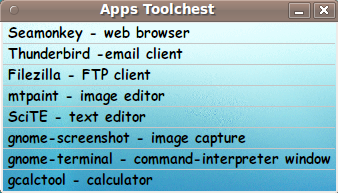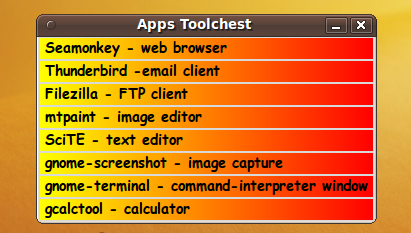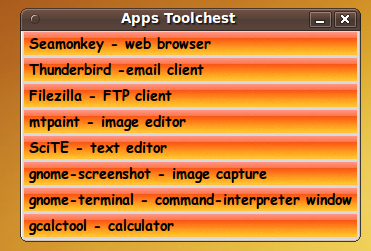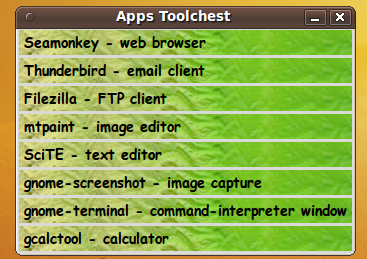|
INTRODUCTION to
'Make Embellished Toolchests' Tk demo scripts
Before retiring in 2005, I had the good fortune to work for about 8
years on
SGI-IRIX (Unix) workstations.
On those workstation 'desktop' screens, there was the concept of
'toolchests' by which one could startup applications.
The toolchests served the same function as the 'Start' menus on PC's.
The main difference in implementation on the SGI desktop is that
the main toolchest started at the top-left of the screen instead of
the bottom left --- and they had a different look --- an
X-Motif look.
After I retired, I thought I would like to make toolchests of apps
and utilities on my Linux PC's.
On the SGI's, to add toolchests, one had to make text files
of a certain format --- to define the 'drawers' of the
toolchest, as well as separator lines and label (group heading)
lines, where needed.
There was an underlying, compiled toolchest-making program on the SGI's
that would make the toolchests from those text files --- both SGI-supplied
toolchests and user-added toolchests.
Unfortunately, there was no such toolchest making program on my PC's
--- at least not a program that I could get into and make work how
I wanted it to work.
In fact, I had a bad experience with application menus, back around 2005,
when using Mandriva Linux with a KDE desktop.
I used the KDE menu editor to make some additions to the app menus,
but there was a bug in the KDE menu system.
Some of my additions would not show.
And when I tried to add them again, I got a message saying
they were already there.
I was caught between a rock and a hard place.
I decided then and there that I was going to make my own
toolchest making system --- using Tcl-Tk to make the toolchests.
I devised a simple format for the text files that
would define the toolchests.
I just had to make a Tcl-Tk script that would read
the lines of the 'chest definition' files and make toolchests.
I wasn't sure that it was possible to make a Tk script
that would read such a text file and generate a
'toolchest' GUI within a fraction of a second.
Let me just say that I was pleasantly surprised.
I decided to make the toolchest 'drawers' with 'button' widgets.
I managed to crank out a 'make_chest.tk' script that had
several sections within a read-loop in the script ---
sections for making
-
'active' drawers
-
inactive (grayed out) drawers
-
label (group-heading) drawers
-
separator lines (made with thin 'frame' widgets).
My Tk-button toolchests ended up looking something like this.
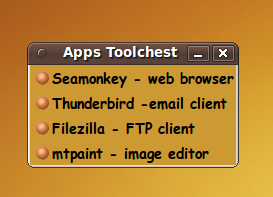
You can see screenshots (and descriptions) of the
more feature-rich toolchests of my 'Freedom Environment'
(FE) software in the 'feAppMenus' and 'feHandyTools' sections of an
FE screenshots gallery page.
With the FE toolchests, the user has the ability to change
the color scheme in the toolchests via a Tk color selector GUI.
You can make that color-selector script by downloading
the code from the page offering
'a non-obfuscated color selector GUI', on this site.
The color scheme of the toolchests
is changed via the 'tk_setPalette' command.
In the FE toolchests, the user can also change (or eliminate) the
'bullet' images used on the left of each drawer.
This is all nice --- but not nice enough.
I am hoping to make more attractive toolchests --- ones
that even Steve Jobs would have envied --- by making variations
on my Tk-button 'make_chest.tk' script.
I was hoping to use the '-compound' parameter of the 'button' command to
provide images BEHIND the text on the drawers --- not just the 'bullet'
images to the LEFT of the text.
But I hit a problem with the '-compound' parameter that is
documented in a 'text on image' wish that I posted on the
page titled 'Tk 9.0 Wishlist' at wiki.tcl.tk.
Since that wish may not be implemented in my lifetime
(and perhaps never), I have been experimenting with
using the 'canvas' widget to make 'embellished'
toolchests.
Three types of toolchests (screenshots)
Below are three images corresponding to three basically different
techniques that I have tried so far.
A description of the basics of each toolchest implementation
is under each image.
|
